Carnivorous Plants: Nature’s Ingenious Predators
Introduction
Carnivorous plants are fascinating examples of nature’s ability to adapt and survive in hostile environments. Unlike typical plants that rely on sunlight, water, and nutrients from the soil, carnivorous plants have developed the remarkable ability to attract, capture, and digest animal prey, most commonly insects. This unique form of adaptation allows them to thrive in nutrient-poor environments where other plants would struggle to survive. The evolutionary paths that led to the development of carnivorous traits have long intrigued scientists and naturalists alike, making these plants not just botanical curiosities, but symbols of life’s ingenuity and resilience.
Carnivorous plants can be found on every continent except Antarctica, inhabiting environments ranging from wetlands to tropical rainforests. They have evolved a variety of methods to lure and trap their prey, including the use of bright colors, nectar, and even deceitful tactics like mimicking flowers or water sources. Once their prey is captured, carnivorous plants use specialized enzymes and bacteria to digest their food and absorb the nutrients they need to grow.
This article explores the incredible world of carnivorous plants, detailing their various trapping mechanisms, habitat adaptations, and the role they play in their ecosystems.
Evolutionary Background of Carnivorous Plants
Carnivorous plants belong to multiple plant families, including Droseraceae, Lentibulariaceae, Sarraceniaceae, and Nepenthaceae, and they are scattered across different parts of the world. Their evolution dates back millions of years, and while they are not all closely related, these plants have converged on similar carnivorous strategies through a process called convergent evolution. This refers to how different species develop similar traits independently to adapt to comparable environments or challenges.
The key environmental factor driving the evolution of carnivory in plants is the lack of available nutrients, particularly nitrogen and phosphorus. These nutrients are essential for plant growth, but in areas such as bogs, wetlands, and tropical rainforests with nutrient-poor soils, plants have limited access to them. To compensate, certain plants evolved mechanisms to capture and digest animal prey, allowing them to supplement their nutrient intake.
Trapping Mechanisms in Carnivorous Plants
One of the most remarkable aspects of carnivorous plants is the variety of trapping mechanisms they have evolved. These mechanisms are highly specialized and demonstrate the ingenuity with which plants can adapt to their surroundings. The five main types of traps include :
- Pitfall Traps (Passive traps)Example: Nepenthes (Pitcher Plants):
Pitfall traps are passive mechanisms where prey falls into a modified leaf or pitcher. These pitchers are often brightly colored and filled with nectar to lure insects. Once the prey slips inside, a waxy or slippery surface prevents it from climbing out. At the bottom of the trap, digestive fluids or symbiotic bacteria break down the prey, allowing the plant to absorb the nutrients. Pitcher plants (Nepenthes and Sarracenia) are some of the most iconic examples of pitfall traps. They have elongated, tubular leaves filled with liquid, and their edges are often slippery or lined with downward-pointing hairs that prevent prey from escaping. In some species, the digestive liquid in the trap is highly acidic, which helps speed up the digestion process.
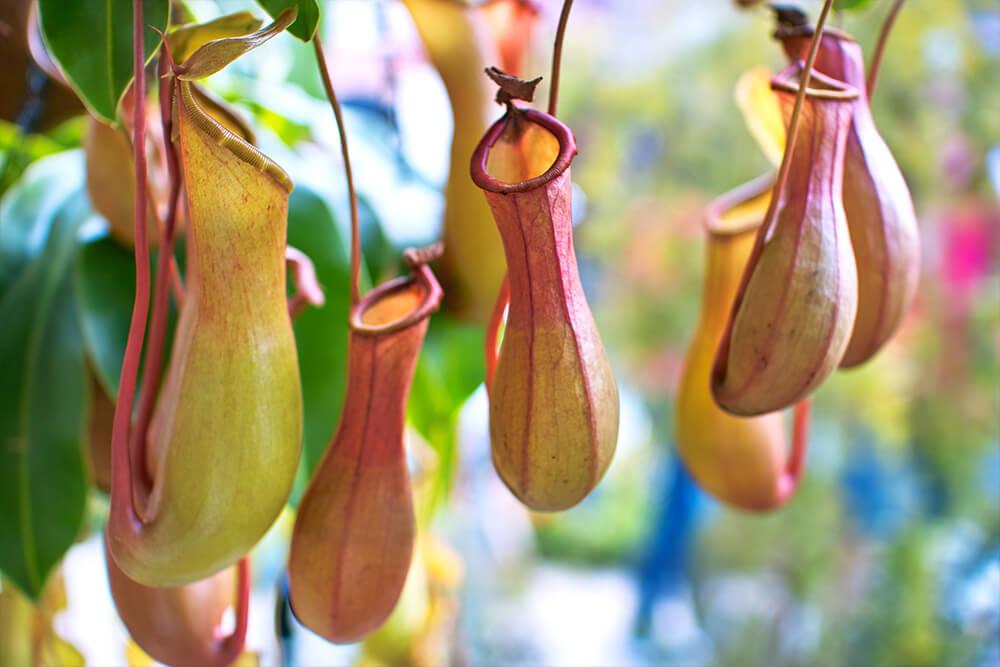
- Snap Traps (Active traps)Example: Dionaea muscipula (Venus Flytrap):
Snap traps are one of the most famous and dramatic carnivorous plant mechanisms. The Venus flytrap is perhaps the most well-known carnivorous plant, with its jaws that snap shut when prey touches trigger hairs. The speed of this reaction is astonishing, with the trap closing in less than a second once the hairs are triggered twice. This trap uses a combination of mechanical energy and electrical signals to close rapidly. After the trap shuts, the plant secretes digestive enzymes to break down the prey over several days. The nutrients are then absorbed, and the trap reopens, ready to catch more prey.
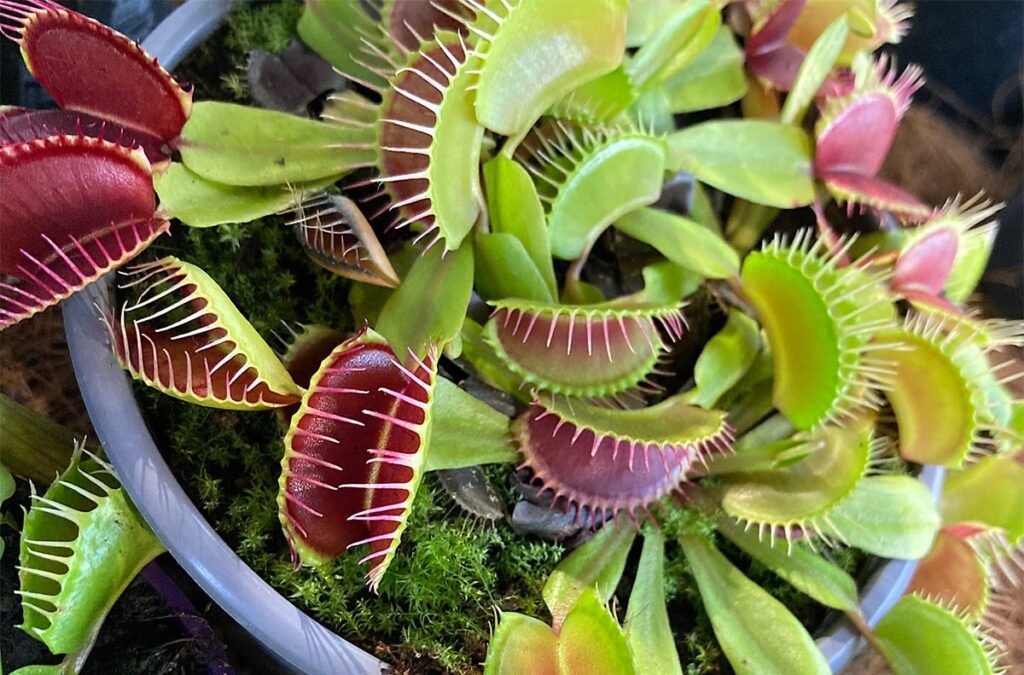
- Suction Traps Example: Utricularia (Bladderworts):
Suction traps are a specialized adaptation found in bladderworts, a group of aquatic carnivorous plants. These plants have small, bladder-like structures that create a vacuum when triggered. The trap door opens briefly, sucking in prey along with water, and then closes to trap the prey inside. This happens in a fraction of a second, making it one of the fastest-known mechanisms in the plant world. Bladderworts are typically found in nutrient-poor, aquatic environments such as lakes, ponds, and marshes, where they feed on tiny aquatic organisms like protozoans and small insects.
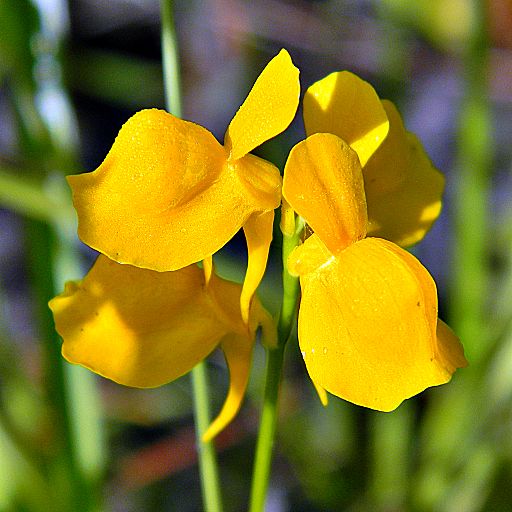
- Flypaper Traps Example: Drosera (Sundews):
Flypaper traps are sticky traps that use a mucilaginous secretion to capture prey. Sundews are a prime example of this trapping mechanism. These plants have leaves covered in glandular hairs that exude sticky, glue-like droplets. When an insect lands on the leaf, it becomes stuck, and the leaf slowly curls around the prey to ensure that it cannot escape. Digestive enzymes are then secreted to break down the prey and absorb its nutrients. Flypaper traps are often found in areas with high humidity, where insects are abundant. The sticky substance not only traps the prey but also prevents water from diluting the digestive enzymes.
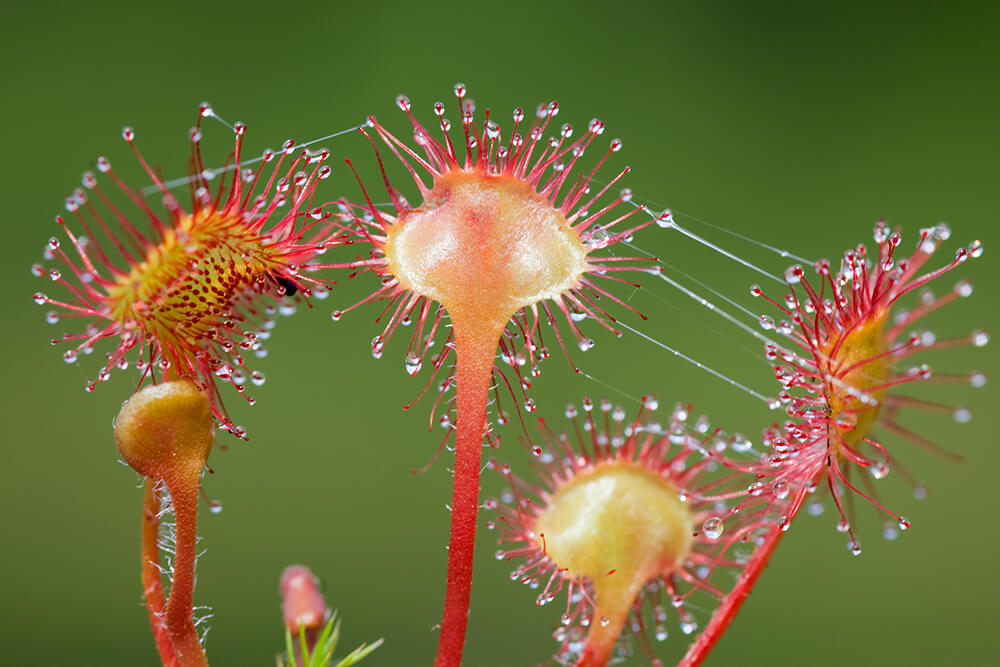
- Lobster-Pot Traps Example: Genlisea (Corkscrew Plants):
Lobster-pot traps are a lesser-known but equally fascinating form of carnivory. These traps are designed in such a way that prey can enter easily but cannot exit. Corkscrew plants are the primary example of lobster-pot traps. They grow in wet, boggy environments and have underground leaves shaped like tubes or spirals. Once small organisms like protozoans or nematodes enter these spirals, they are guided deeper into the trap by inward-pointing hairs. Eventually, they reach a chamber where digestive enzymes break them down.
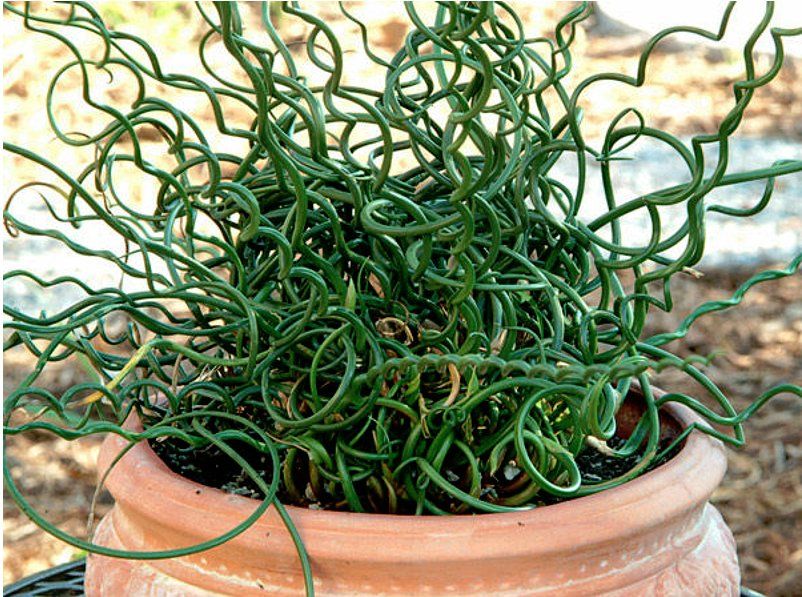
Habitats of Carnivorous Plants
Carnivorous plants are typically found in environments where nutrient levels, especially nitrogen, are very low. These environments include:
- Bogs and Fens:
Bogs and fens are wetland ecosystems characterized by acidic, nutrient-poor soils. Plants like Sarracenia (North American pitcher plants) and Drosera (sundews) thrive in these environments by supplementing their nutrient intake through carnivory. Bogs are often waterlogged, and the anaerobic conditions slow down the decomposition of organic matter, limiting the availability of nitrogen and phosphorus.
- Tropical Rainforests:
Tropical rainforests are home to several species of carnivorous plants, including Nepenthes (tropical pitcher plants). Despite the abundance of plant life in rainforests, the soil is often nutrient-poor due to heavy rainfall leaching nutrients away. Carnivorous plants in these environments have evolved elaborate traps to capture insects and other small animals to survive.
- Aquatic Habitats:
Aquatic carnivorous plants like Utricularia (bladderworts) are found in lakes, ponds, and marshes, where they use suction traps to capture tiny aquatic organisms. These habitats are often low in nutrients, making carnivory a valuable adaptation.
- Savannas and Grasslands:
In some parts of the world, carnivorous plants can be found in open, sunny habitats like savannas and grasslands. These environments often have poor, sandy soils with low nutrient content, making carnivory an advantageous strategy for obtaining nitrogen and phosphorus.
Ecological Role and Importance
Carnivorous plants play a crucial role in their ecosystems. By controlling insect populations, they help maintain the balance of their environments. In some cases, these plants serve as mutualistic hosts for certain insects, providing shelter while benefiting from the nutrients left behind by prey remains.
Additionally, carnivorous plants are important indicators of ecosystem health. Because they thrive in nutrient-poor, sensitive habitats, the presence or absence of carnivorous plants can signal changes in environmental conditions, such as nutrient pollution or habitat destruction.
Conservation efforts are critical for many species of carnivorous plants, as habitat loss, climate change, and poaching threaten their survival. Wetlands and bogs, which are common habitats for carnivorous plants, are often drained for agriculture or development, leading to a decline in plant populations.
Popular Species of Carnivorous Plants
Venus Flytrap (Dionaea muscipula)
Native to North Carolina and South Carolina, the Venus flytrap is one of the most famous carnivorous plants. It uses snap traps to catch insects and arachnids.
Tropical Pitcher Plants (Nepenthes spp.)
Found primarily in Southeast Asia, these large pitcher plants can grow several meters tall and capture a wide range of prey, including insects, small vertebrates, and even birds in rare cases.
North American Pitcher Plants (Sarracenia spp.)
Native to the southeastern United States, these pitcher plants have highly specialized pitfall traps designed to capture insects and digest them for nutrients.
Sundews (Drosera spp.)
Found on every continent except Antarctica, sundews use sticky flypaper traps to capture prey, which they then digest with enzymes secreted by their glandular hairs.
Bladderworts (Utricularia spp.)
Aquatic or semi-aquatic, bladderworts are remarkable for their suction traps, which are capable of capturing tiny prey in a fraction of a second.
Conclusion
Carnivorous plants represent some of the most remarkable adaptations in the plant kingdom. From the Venus flytrap’s rapid movements to the ingenious bladderwort’s suction traps, these plants have evolved to capture and digest animal prey in environments where other plants struggle to survive. Their diversity and the range of environments they inhabit are a testament to the power of evolution and adaptation.
Despite their allure and ecological importance, many species of carnivorous plants are threatened by habitat destruction and environmental changes. Conservation efforts aimed at protecting their habitats are essential to preserving these fascinating plants for future generations to study and enjoy.
3 thoughts on “Carnivorous Plants: Nature’s Ingenious Predators”
As a Newbie, I am constantly exploring online for articles that can benefit me. Thank you
Can I ask a quick question about your site? https://google.com/?Quita
RoQuita
ya sure